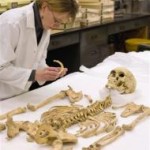 The Smithsonian’s National Museum of Natural History is putting on an exhibit of artifacts and bones from the early settlers in the Chesapeake area. Through these remains, you can discover a great deal about how the early colonials and their slaves lived.
The Smithsonian’s National Museum of Natural History is putting on an exhibit of artifacts and bones from the early settlers in the Chesapeake area. Through these remains, you can discover a great deal about how the early colonials and their slaves lived.
The bones on exhibit tell a tale of lives lived and lost.
“Lifelong, backbreaking labor marked the bones of men, women and children who tended fields. Most are nameless now, their stories lost — until we find their remains,” proclaims the greeting for visitors in a section on working life.
For example, consider tailor’s notches and shoemakers femur.
Studying these ancient bones tells the scientists that one lady was a tailor, her front teeth marked by tiny notches from holding pins. Another thigh bone shows its owner was a shoemaker, the bone changed by the pounding of leather and nails into boots braced on the man’s leg.
And those were the good jobs. Damn we have it easy.
A more fancy find was the grave and remains of Captain Bartholomew Gosnold. They determined his identity based on his age, no apparent cause of death and the captain’s accouterments buried with him. Gosnold is the man who named Cape Cod (after the fish) and Martha’s Vineyard (after his daughter) during an expedition to New England in 1602.
They also have a section on 17th c. medicine, including a scary set of doctor’s tools. I love scary medical history. That’s the best kind.
There’s also an overall focus on forensics, on what the remains can tell us, which is very exciting. Most of the time museum exhibits focus on results, not the process. The popularity of investigative procedurals like CSI or my personal favorite, Bones, has brought the background work into the foreground.
Here’s a great albeit brief intro video of Smithsonian forensic anthropologist Doug Owsley examining some of the bones on display.
[youtube=http://www.youtube.com/v/So6L3s1tc2E&w=430]
:skull: